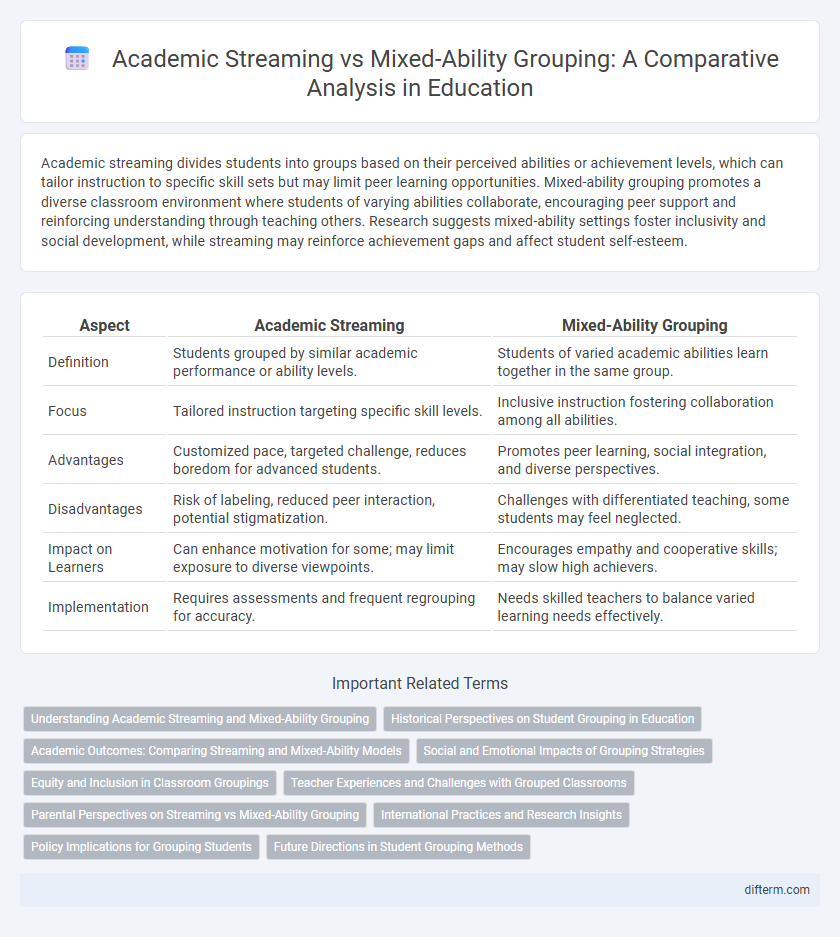Academic streaming divides students into groups based on their perceived abilities or achievement levels, which can tailor instruction to specific skill sets but may limit peer learning opportunities. Mixed-ability grouping promotes a diverse classroom environment where students of varying abilities collaborate, encouraging peer support and reinforcing understanding through teaching others. Research suggests mixed-ability settings foster inclusivity and social development, while streaming may reinforce achievement gaps and affect student self-esteem.
Table of Comparison
| Aspect | Academic Streaming | Mixed-Ability Grouping |
|---|---|---|
| Definition | Students grouped by similar academic performance or ability levels. | Students of varied academic abilities learn together in the same group. |
| Focus | Tailored instruction targeting specific skill levels. | Inclusive instruction fostering collaboration among all abilities. |
| Advantages | Customized pace, targeted challenge, reduces boredom for advanced students. | Promotes peer learning, social integration, and diverse perspectives. |
| Disadvantages | Risk of labeling, reduced peer interaction, potential stigmatization. | Challenges with differentiated teaching, some students may feel neglected. |
| Impact on Learners | Can enhance motivation for some; may limit exposure to diverse viewpoints. | Encourages empathy and cooperative skills; may slow high achievers. |
| Implementation | Requires assessments and frequent regrouping for accuracy. | Needs skilled teachers to balance varied learning needs effectively. |
Understanding Academic Streaming and Mixed-Ability Grouping
Academic streaming divides students based on ability or achievement levels to tailor instruction more precisely, often resulting in homogeneous classrooms. Mixed-ability grouping combines students of varying skills and knowledge, promoting peer learning and social interaction while challenging educators to differentiate instruction effectively. Research highlights that mixed-ability settings can foster inclusivity and collaboration, whereas streaming may enhance targeted skill development but risk reinforcing educational inequalities.
Historical Perspectives on Student Grouping in Education
Academic streaming emerged in the early 20th century as a method to categorize students by perceived ability, emphasizing tailored curricula to optimize learning outcomes. Mixed-ability grouping gained prominence in the late 20th century, challenging the segregation inherent in streaming by promoting inclusive classrooms aimed at enhancing social integration and peer learning. Historical debates on student grouping reflect ongoing tensions between educational equity and differentiated instruction approaches.
Academic Outcomes: Comparing Streaming and Mixed-Ability Models
Academic streaming often leads to higher achievement in standardized test scores for top-performing students, while mixed-ability grouping supports a more inclusive learning environment that can improve overall class engagement and reduce achievement gaps. Research shows that streaming may enhance motivation and targeted instruction for advanced learners but risks limiting opportunities for peer learning and social integration among diverse ability levels. Mixed-ability models promote collaborative skills and adaptive teaching strategies, contributing to long-term academic resilience and equity across student populations.
Social and Emotional Impacts of Grouping Strategies
Academic streaming often leads to social segregation, which can impact students' self-esteem and peer relationships negatively. Mixed-ability grouping promotes inclusivity and collaboration, fostering empathy and social skills among diverse learners. Emotional well-being improves in environments where students feel accepted regardless of academic performance.
Equity and Inclusion in Classroom Groupings
Academic streaming often reinforces educational inequalities by segregating students based on perceived ability, limiting opportunities for diverse perspectives and peer learning. Mixed-ability grouping promotes equity and inclusion by fostering collaboration among students with varied skills and backgrounds, enhancing social integration and reducing stigma. Research indicates that inclusive classroom groupings improve overall academic outcomes and support the development of critical interpersonal skills.
Teacher Experiences and Challenges with Grouped Classrooms
Teacher experiences with academic streaming reveal challenges such as managing diverse student needs and balancing curriculum pacing to accommodate varied academic levels. In mixed-ability grouping, educators often face difficulties in differentiating instruction effectively while maintaining engagement for both advanced and struggling learners. Classroom management complexities and increased planning demands underscore the need for targeted professional development and collaborative teaching strategies.
Parental Perspectives on Streaming vs Mixed-Ability Grouping
Parents often express varied opinions on academic streaming versus mixed-ability grouping, with many favoring streaming for its tailored instruction that can accelerate gifted students' progress. Concerns about mixed-ability grouping include fears that high-achieving children may be held back while lower-performing students receive less attention. Research indicates that parental support and perceptions profoundly influence school policies and the effectiveness of either grouping method.
International Practices and Research Insights
Academic streaming segments students by ability or achievement, often leading to tailored curricula but potentially reinforcing educational inequalities, as noted in studies from countries like Finland and Singapore. Mixed-ability grouping promotes inclusive classrooms where differentiated instruction supports diverse learners, improving social integration and reducing stigma according to research conducted in Canada and the UK. International research highlights that mixed-ability strategies, when paired with effective teacher training and resources, generally yield higher overall student engagement and equitable learning outcomes.
Policy Implications for Grouping Students
Academic streaming involves grouping students by ability or achievement, which can lead to tailored instruction but may reinforce social inequalities and limit peer learning opportunities. Mixed-ability grouping promotes diverse interactions and inclusive teaching strategies but requires substantial teacher training and resources to address varied learning needs effectively. Education policies must balance equity and excellence by providing support structures that mitigate the drawbacks of both grouping methods while fostering individualized learning pathways.
Future Directions in Student Grouping Methods
Emerging trends in education advocate for flexible student grouping methods that balance academic streaming and mixed-ability approaches to enhance personalized learning outcomes. Integrating adaptive technologies with data-driven assessments enables dynamic regrouping based on individual progress and skills rather than static academic levels. Future research emphasizes equity and inclusivity by designing hybrid models that foster peer collaboration while addressing diverse learner needs.
academic streaming vs mixed-ability grouping Infographic

 difterm.com
difterm.com